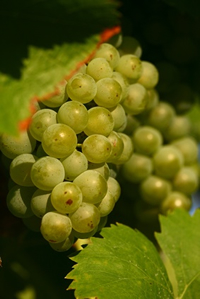Untitled Document

|
Müller-Thurgau
Also known as: Rivaner
|

Photo: © sunset man - Fotolia.com |
The Müller-Thurgau grape is Germany's second most planted grape. It is planted in every wine region and covers 34,565 acres (13,988 hectares), accounting for 13.7% of Germany's vineyards. It is planted in every wine region, with the largest planting being found in the Rheinhessen and Baden regions.
Müller-Thurgau grape was first bred in Geisenheim (in the Rheingau region) in 1882 by Professor Hermann Müller from Thurgau, Switzerland. The grape was named after him in 1913. For many years, it was believed that the grape was a cross between the Riesling and Silvaner grapes. However, with the help of recent genetic analysis, it was discovered that the Müller-Thurgau grape is actually a cross between the Riesling and Madeleine Royale grapes.
Müller-Thurgau grapes produce enjoyable, drinkable, flowery wines that are mildly acidic. The wines often show hints of nutmeg, apple, black currant, and apricot aromas. Müller-Thurgau wines are pale to light yellow in color and are medium bodied. They are, however, not good for long storage - they are best enjoyed in the years immediately following the harvest. Müller-Thurgau wines labeled as "Rivaner" are usually drier and lighter.
Müller-Thurgau wines pair well with light dishes, such as vegetable dishes (especially asparagus) and salads. |
|
|

